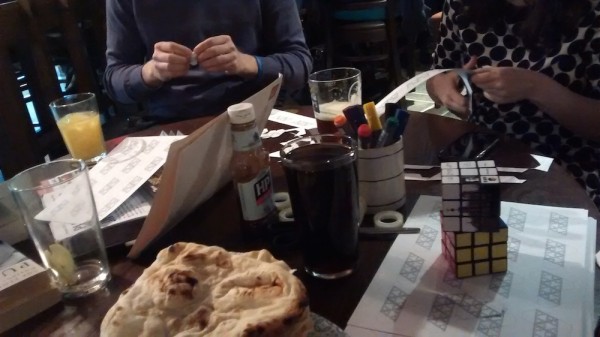I know I usually write up the goings-on at Manchester MathsJam, but since I spent much of the last month ‘In Residence’ at the University of Greenwich, I spent the second-to-last Tuesday evening of May at the London MathsJam. Here’s a summary of what transpired.
We spent a good while building Sierpinski tetrahedra for me to take back to the exhibit at Greenwich. Pub manufacturing standards are slightly lower, due to it being a bit dark and all the beer and so on, but we managed to construct a 64-tetrahedron pyramid, which I took back. The smallest pyramids are made using a simple tetrahedron net printed up with the Sierpinski triangle design, then taped together at the corners.
Some discussion of pyramid-related puzzles ensued:
- If you have a regular pentagon-based pyramid, is it possible to slice it in a single plane so that the cross-section is a regular hexagon?
- If you build a square-based pyramid with a square and four equilateral triangles, then disassemble it and use the same triangles to make a tetrahedron, what is the ratio between the areas of the two solids?
- If four ants stand at the corners of a tetrahedron, and each set off walking with the same speed along a randomly chosen edge, what’s the probability that no ants meet at a corner, or pass each other going in opposite directions?
A nice puzzle with overlapping circles was passed around: If three circles are placed in a line with overlaps between each pair, can you arrange the numbers 1-5 in each of the five sections so that the numbers in each individual circle total to the same answer?
Now, level up: four overlapping circles in a line, and the numbers 1-7?
Serious business: five overlapping circles, and the numbers 1-9?
Colm Mulcahy, aka Card Colm, was visiting London and came by to see us. He showed us some amazing card tricks, but I can’t remember any, so you’ll have to buy his book.
Some people were looking at the Advanced version of Cheryl’s Birthday Puzzle.
A pile of humans from UCL’s Chalkdust Magazine were in attendance, and are dead nice. They helped out with building tetrahedra, and also brought along a few puzzles, including their £100 prize number crossword.
